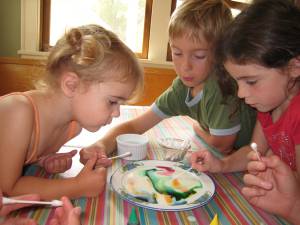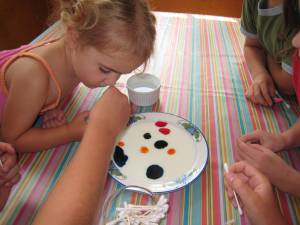
Using cranberries and baking soda, you can create invisible messages that will be revealed to friendly eyes and self-destruct before your enemies have a chance to read them. You’ll see how some pigments in fruit can change color when they’re exposed to an acid or a base.
I showed viewers how to make Spy Juice on Kare11 this morning. Here’s the link, if you want to watch a video demonstration!
You will need half a bag of cranberries, water, baking soda and some printer paper. To write your message, you’ll also want to find a small paintbrush, Q-tip, or something else with an absorbent tip. We made our own pens by wrapping a tiny piece of paper towel around the pointed end of a wooden skewer and winding scotch tape around to secure it. Be sure to put on an apron or wear old clothes for this experiment, since cranberry juice stains!
Have an adult or teenager boil the cranberries in about three cups of water for 15 or 20 minutes. Be sure to put a lid on the pan, since the small pockets of air that help cranberries float can make them explode as they cook. If you listen, you’ll hear some of the them popping! Crush the cooked berries and push the liquid through a sieve or colander to collect the concentrated cranberry juice. Most cranberry juice from the grocery store is diluted with water, corn syrup and other juices and won’t work as well!
Let the juice cool and pour it into a casserole dish or cake pan that the paper you’re writing your messages on will fit into. If your cranberry juice seems thick and syrupy, add a little water (maybe half a cup.) It has to have enough water in it so that it will soak into the paper!
Add a few teaspoons of baking soda to about 1/3 cup of warm water and dissolve it as well as you can. (Don’t worry if you can still see some baking soda.) Using a Q-tip, paintbrush, or your homemade writing tool, use the baking soda solution to write a message on your paper. It may take a little practice, so don’t get frustrated. You’ll get the hang of it!

Let your message air dry, or speed things up with a blow dryer.
To reveal your message, place your paper in the cranberry juice and see what happens!

The science behind the fun:
Cranberries contain pigments called anthocyanins (an-tho-SY-a-nins), which give them their bright color. In nature, these pigments attract birds and other animals to fruit. This is important because animals eat the berries and spread plants seeds from one place to another.
These pigments, called flavanoids, change color when they come in contact with acids and bases. Cranberry juice is very acidic, and the pigment is red in acids. When you add it to a base, it turns purple or blue. Baking soda is a base, so your baking soda message will turn blue when it comes into contact with the pigments in the cranberry juice. Eventually, when enough cranberry juice soaks into the paper, it will dilute the baking soda and make the paper acidic, turning the pigment back to red and your message will disappear!
There are over 300 kinds of anthocyanins which are found in many fruits and vegetables including blueberries, red cabbage, grapes and blueberries. Scientists think they may have many health benefits and some researchers are even making organic solar cells using flavanoids!
What other juices can you use to reveal secret messages? What other bases could you use as ink?
Try making your own recipe for spy juice! I’d love to hear how red cabbage works! Check out my red cabbage litmus paper experiment to find out how to make red cabbage juice.
Let me know what works best!










